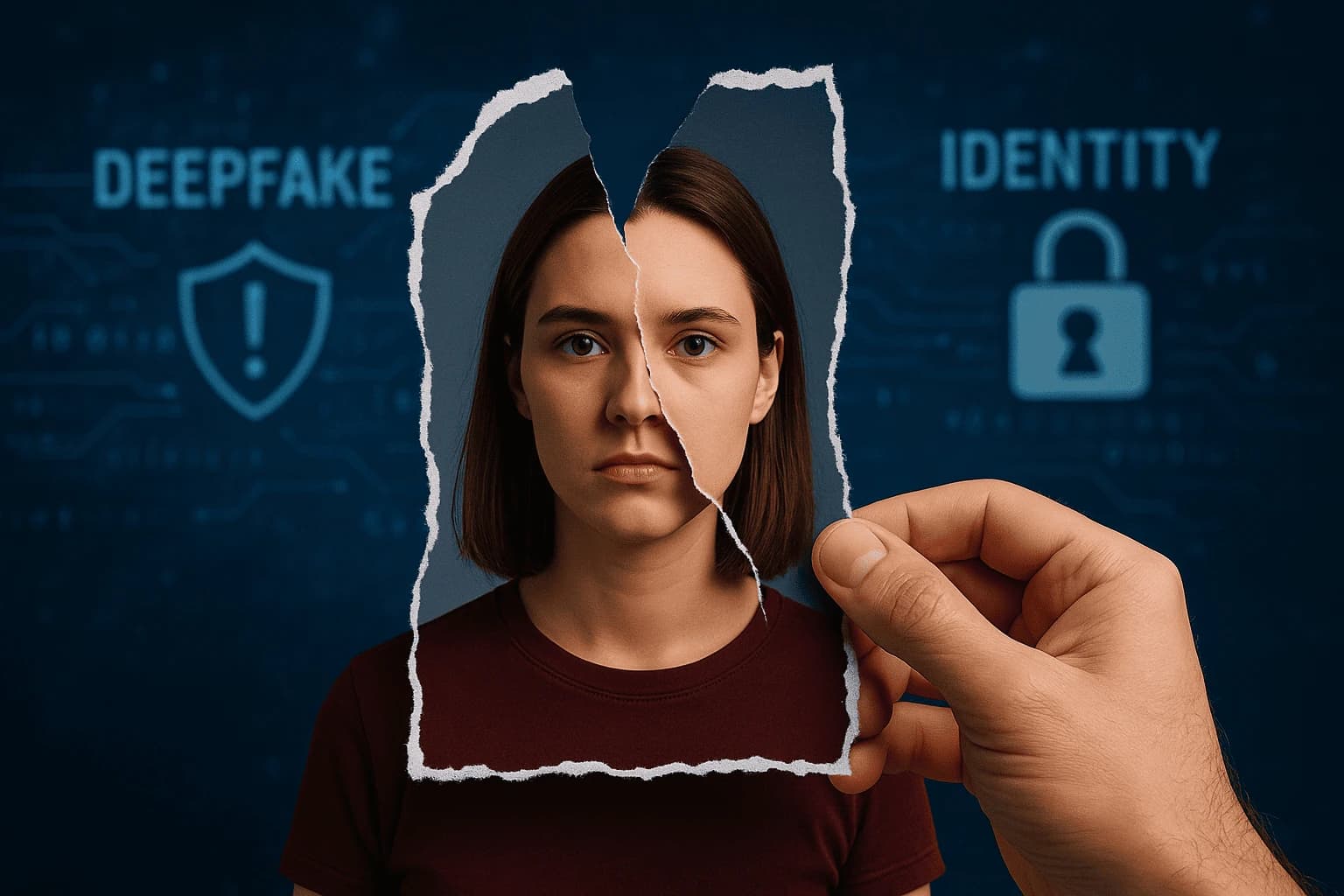
* All product/brand names, logos, and trademarks are property of their respective owners.
Artificial intelligence is changing the way we create and share media—and one of its most controversial uses is deepfakes. These are highly realistic fake videos, voices, or images made using AI to mimic real people. What started as a lab experiment is now a tool anyone can use, for fun—or fraud.
Deepfakes rely on machine learning, especially something called GANs (Generative Adversarial Networks), to create media that looks and sounds real. From fake political speeches to CEOs authorizing fake wire transfers, deepfakes are making it hard to tell truth from fiction.
The results can be serious. In 2024, scammers used a deepfake to trick a company into sending $25 million. Voice clones have fooled families into handing over money. And fake explicit videos have harmed people’s reputations and privacy.
At its core, the deepfake scam is about trust. If AI can fake anything, how can we know what’s real? Governments, companies, and individuals are all trying to catch up, building tools and laws to stop these threats.
In this blog, we’ll look at how deepfakes work, how they spread lies and steal identities, and what we can do to fight back. Because in the age of AI deception, knowing the truth matters more than ever.
At the heart of deepfake creation lies a sophisticated marriage of mathematics, machine learning, and media manipulation. The main engine driving deepfakes is called a Generative Adversarial Network (GAN)—a type of AI that pits two neural networks against each other: a generator and a discriminator. The generator creates fake images or videos, while the discriminator tries to tell if they're real or fake. Through continuous feedback, the generator improves until the output becomes nearly indistinguishable from authentic media.
In simpler terms, GANs function like a digital counterfeiter learning to forge currency, while the bank keeps rejecting bad bills. Over time, the counterfeiter gets better—until the fake is nearly flawless.
For more personalized deepfakes—like face swaps or voice clones—autoencoders are used. These neural networks compress an image or audio file into a compact form, then reconstruct it using another person’s features. This allows a video to overlay one person’s expressions or voice onto another, pixel by pixel, tone by tone.
Voice cloning, often powered by text-to-speech AI like Tacotron, Descript’s Overdub, or ElevenLabs, adds another layer of realism. With just a few seconds of recorded speech, AI models can create highly convincing synthetic voices—making scams and impersonations alarmingly easy to execute.
What was once the domain of data scientists is now DIY. Tools like DeepFaceLab, FaceSwap, and Wav2Lip allow virtually anyone with basic technical skills to generate convincing deepfake videos. Platforms such as Synthesia, Reface, and Zao make it even easier—drag, drop, and generate.
These tools often come with step-by-step tutorials, pre-trained models, and community forums that make it accessible even to amateurs. The ease of use and increasing computing power means that barriers to entry are falling, fast.
In the era of instant media and viral content, deepfakes have become a formidable tool in political manipulation. With just a few clicks, a politician’s speech can be fabricated to include inflammatory remarks, fake policy announcements, or endorsements they never gave. These synthetic videos often surface close to elections, sowing confusion and eroding public trust in democratic institutions.
One infamous example was the deepfake of Ukrainian President Volodymyr Zelenskyy appearing to tell soldiers to surrender—a video released on social media in 2022 during the Russian invasion. Though quickly debunked, it demonstrated how convincing and dangerous these videos can be in real-time conflict scenarios.
Deepfakes have also emerged in domestic political campaigns, where altered footage or cloned voices are used to discredit opponents, manipulate minority voters, or amplify false narratives. The speed at which these clips spread—and the emotional response they trigger—makes damage control incredibly difficult.
The real power of deepfakes lies not just in their creation, but in their distribution. Social media platforms—like TikTok, X (Twitter), Facebook, and Instagram—are fertile ground for misinformation. Algorithms favor sensational and emotionally charged content, where deepfakes easily deliver.
These platforms often serve as echo chambers where AI and misinformation is shared, reshared, and accepted as fact before verification can catch up. Worse still, bad actors use bots to rapidly boost engagement, making synthetic media seem widely accepted or verified.
Deepfakes fit seamlessly into existing fake news ecosystems, reinforcing conspiracy theories and widening political divides. They can be embedded in articles, memes, or out-of-context reposts, making them harder to trace and discredit.
The result is a toxic mix of plausibility and virality. Even after a deepfake is debunked, the false impression often lingers—a phenomenon known as the “continued influence effect.” In this digital arms race, misinformation doesn’t need to be true—it just needs to be believable for long enough to do damage.
Deepfakes are not just a tool for misinformation—they're an increasingly common weapon in financial fraud and identity theft. Cybercriminals are now using voice and video deepfakes to impersonate executives, relatives, or service agents in real-time scams that have led to massive losses.
In 2024, a Hong Kong-based company was defrauded of HK$200 million (~$25 million USD) when an employee received a video call from a "familiar" executive requesting a fund transfer. The caller was a deepfake—perfectly mimicking voice, facial expressions, and gestures. The transaction was completed before suspicion arose.
Even more disturbingly, voice cloning is being weaponized in “Hi Mum” scams—fraudsters send urgent voice messages or calls mimicking family members in distress. Victims, believing they’re helping loved ones, transfer money without hesitation. These emotional triggers make deepfakes psychologically powerful, bypassing rational scrutiny.
As deepfake technology gets better, these scams are becoming more targeted and scalable. Criminals only need short voice or video samples—often taken from social media—to train an AI model capable of impersonation.
One of the most harmful uses of deepfakes is in non-consensual pornography, where faces—often of celebrities, influencers, or ex-partners—are inserted into explicit content without their consent. These videos are disturbingly realistic and can spread rapidly across adult sites, social media, and dark web forums.
For victims, the damage is psychological, reputational, and often irreversible. Many report harassment, job loss, and severe mental health consequences. According to 2025 reports, over 90% of deepfake porn targets are women, highlighting its role as a gendered tool of abuse and control.
Legal protections remain limited and inconsistent globally. In some regions, such acts fall into gray areas of harassment or defamation law. The U.S. recently introduced the “TAKE IT DOWN” Act to help victims remove such content, but enforcement is still evolving.
What makes deepfake identity theft so insidious is its invisibility—most victims don’t even realize their likeness is being misused until the damage is done. And unlike passwords or credit card numbers, you can't change your face or voice.
As deepfakes become more convincing, a parallel race is underway to detect and neutralize them. A growing number of AI-powered tools and startups are tackling this problem, each with different approaches and capabilities.
FakeCatcher (Intel): Uses subtle blood flow patterns in the face to detect authenticity in real-time videos—claiming up to 96% accuracy.
Hive AI: Offers enterprise-level deepfake detection integrated into social platforms and content moderation systems.
Sensity AI: Monitors video manipulation threats across the web, used by banks and governments.
Deepware Scanner: Focused on mobile and API-based detection, helping users check whether a video is AI-generated.
WeVerify & InVID: Open-source tools used by journalists for forensic video verification, including metadata checks, reverse image search, and keyframe analysis.
ValidSoft Voice Verity: Specializes in voice authentication, distinguishing between real and synthetic voices in call centers and banking apps.
These tools utilize a combination of facial expression analysis, pixel-level inconsistencies, metadata forensics, and AI-based learning to distinguish fakes from authentic content. Yet, none are foolproof—especially against high-quality or real-time deepfakes.
Despite advances in detection technology, the battle against deepfakes remains deeply asymmetrical. Why? Because AI evolves on both sides—as detectors improve, so do the forgers. New deepfake generators can now mimic eye blinking, facial microexpressions, and even biological signals like breathing—once telltale signs of fakery.
Moreover, most detection systems require high-resolution inputs and may not function well with compressed or altered media—exactly the kind of content shared on social media. Worse, adversarial attacks can even “poison” detectors by adding imperceptible noise that bypasses AI scrutiny.
Another challenge is adoption. Most organizations still lack access to cutting-edge tools, and verification isn’t yet baked into platforms like YouTube, TikTok, or Zoom. Without mainstream integration, even the best detection technology is limited in reach.
As synthetic media gets more advanced, the line between real and fake is becoming nearly impossible to define—forcing society to rethink what constitutes proof, truth, and trust in the digital age.
In the United States, the 2025 “TAKE IT DOWN” Act gives individuals the right to request removal of non-consensual deepfake content, including sexually explicit material and manipulated impersonations. However, the burden of proof often falls on the victim, and laws vary by state.
The European Union’s AI Act is one of the most comprehensive efforts to regulate high-risk AI applications, including deepfakes. It mandates labeling requirements for synthetic content and restricts the use of AI in biometric surveillance—but critics argue it doesn’t go far enough on enforcement and cross-border accountability.
Countries like India and South Korea are beginning to prosecute deepfake-related crimes under broader identity theft or cybercrime laws, while Australia has issued digital identity guidelines for AI impersonation cases. Yet, global consensus is lacking, and there is no unified international treaty on synthetic media.
A major legal gap is the real-time abuse of deepfakes—where evidence disappears quickly or leaves no trace. Another challenge is cross-platform regulation, as content often crosses borders before it can be taken down or flagged.
Deepfakes are no longer a futuristic novelty—they're a present-day challenge redefining how we trust what we see and hear. As we've explored, this technology, fueled by powerful AI, offers creative potential but is increasingly being exploited to spread misinformation and commit identity theft.
We’ve uncovered how deepfakes are crafted through advanced machine learning models like GANs and voice cloning tools, and how easily accessible software has democratized their creation. We’ve seen the chilling impact of deepfakes in political deception, financial scams, and personal privacy violations. From fake news influencing elections to cloned voices scamming loved ones, the threat is widespread and evolving fast.
While detection technologies and legal frameworks are beginning to catch up, they remain fragmented and often reactive. Global laws vary, enforcement is inconsistent, and many users are still unaware of the risks. This is why awareness and education are now more vital than ever.
The fight against deepfakes isn’t just technical—it’s social, ethical, and deeply human. As creators, consumers, and citizens of the digital age, we must learn to question what we see, verify what we hear, and advocate for stronger protections.
The line between reality and fabrication has blurred. But with vigilance, innovation, and shared responsibility, we can reclaim trust in our digital world—one verified truth at a time.

22 November 2025
No comments yet. Be the first to comment!